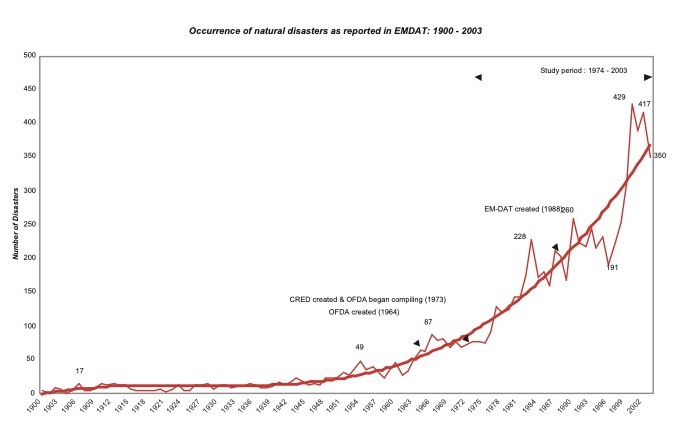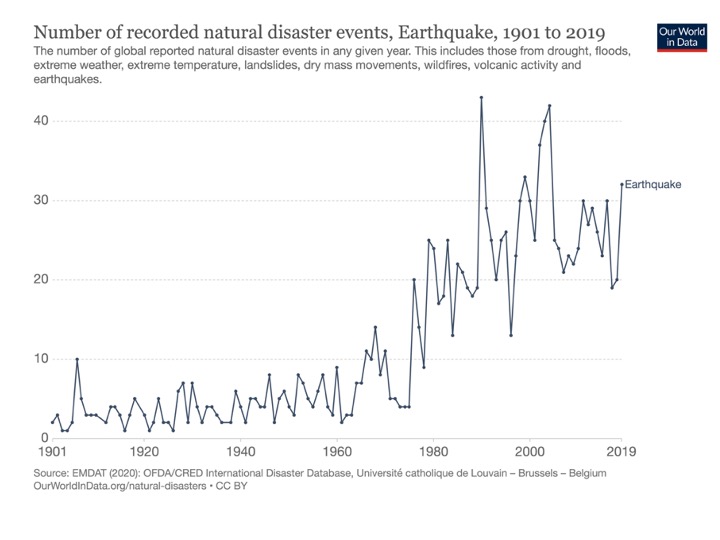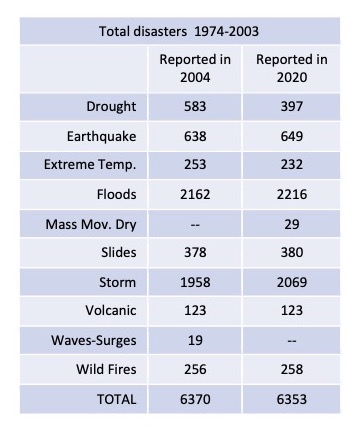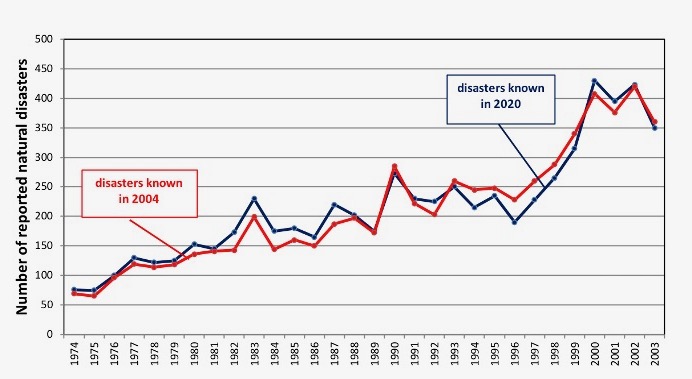Some comments on a recent report by UN and CRED
by Gianluca Alimonti and Luigi Mariani
On October the 13th, on the international day for the reduction of the risk of disasters, the UN report was released (ONU2020) “Human cost of disasters – An overview of the last 20 years 2000-2019” (https://www.undrr.org/publication/human-cost-disasters-overview-last-20-years-2000-2019) (hereafter UNDRR report), based on data from EM-DAT CRED (Center for Research on the Epidemiology of Disasters) dataset of the Catholic University of Leuven in Belgium.
The conclusion of the report is that these events have almost doubled, going from 4212 in the two decades 1980-1999 to 7348 in the period 2000-2019, going so far as to speak of a “staggering rise in climate-related disasters over the last twenty years ” to the point of claiming that “we are turning our only home into an uninhabitable hell for millions of people”.
The report deals also with deaths and economic losses[1] but in this paper we will only consider the number of disasters and we will try to analyze their consistency.
Observing the graph of natural disasters starting from 1900 (CRED2004) we observe a substantial apparent absence of these events up to the middle of the last century, when a sudden growth begins, until the end of the twentieth century. This trend is very strange: is it possible that natural disasters « started » in the middle of the twentieth century with an apparent dramatic growth until the end of the century? Such a trend would be « consistent » with the growth of the global temperature of our planet and consequently the UNDRR reported “This is clear evidence that in a world where the global average temperature in 2019 was 1.1 degrees Celsius above the pre-industrial period, the impacts are being felt in the increased frequency of extreme weather events including heatwaves, droughts, flooding, winter storms, hurricanes and wildfires”.

On the other hand, in previous reports, CRED has always warned about an exclusively climatological interpretation of the increase in events observed until the end of the twentieth century: for example CRED in 2004 (CRED2004) wrote “Figure 2 (above) might lead one to believe that disasters occur more frequently today than in the beginning of the century. However, reaching such a conclusion based only on this graph would be incorrect. In fact, what the figure is really showing is the evolution of the registration of natural disaster events over time”.
This concept was again stressed in 2007 “Indeed, justifying the upward trend in hydro-meteorological disaster occurrence and impacts essentially through climate change would be misleading. … one major contributor to the increase in disasters occurrence over the last decades is the constantly improving diffusion and accuracy of disaster related information“(CRED2007) and in 2015 “From a disasters analysis point of view, population growth and patterns of economic development are more important than climate change or cyclical variations in weather when explaining this upward trend. Today, not only are more people in harm’s way than there were 50 years ago, but building in flood plains, earthquakes zones and other high-risk areas has increased the likelihood that a routine natural hazard will become a major catastrophe.” (CRED2015)
In support of this message there is also the growth of earthquakes, which certainly can have nothing in common with climatic conditions, very similar to the increase in all natural disasters: the increase in recorded earthquakes can reasonably be almost entirely the result of better reporting.

Also in the UNDRR report the warning to the reader is present, but in a very softened version and the dominant today climate-catastrophic interpretation definitely prevails“While better recording and reporting may partly explain some of the increase in events, much of it is due to a significant rise in the number of climate-related disasters “
What is the reason for this climate-centric interpretation? Perhaps a revision of the pre-2000 data?
Let’s go back to the CRED 2004 report (CRED2004) and let’s make a comparison between the data underlying the conclusions then reported and the data relating to the same years but extracted today from the public CRED database.

The table does not show any significant increase, possibly a slight decrease, but the data are essentially in agreement.
Going for a more detailed comparison, even the annual disaster analysis shows a substantial agreement between the data referred to in the 2004 CRED report with those currently present in the CRED database.

The figure shows the time series 1974-2003 of natural disasters as now reported in the CRED database (blue line) and as shown in figure 5 of CRED 2004 report (red line).
Both comparisons, for the total number of natural disasters in the period, and year by year, show that the data have not changed significantly. The trend of natural disasters, since the time when their reporting can be considered reliable according to the CRED researchers, even shows a 15% decrease from 2000 to today.
Given this conclusion, what is the reason why the message issued in the UNDRR report speaks of a “staggering rise in climate-related disasters over the last twenty years » up to the point that « we are turning our only home into an uninhabitable hell for millions of people « , thereby ignoring the calls for caution in the data interpretation expressed several times by CRED?
On October the 21st we have directly posed this question to the CRED Director Debarati Guha-Sapir who diplomatically turned it over to Denis McClean, the UN official that co-authored the UNDRR report. With an email on November the 4th we solicited an answer from Dr McClean but we are still awaiting for it.
REFERENCES
(ONU2020) Human cost of disasters – An overview of the last 20 years 2000-2019
(CRED2004) Thirty Years Of Natural Disasters 1974-2003: The Numbers, CRED 2004
(CRED2007) Annual Disaster Statistical Review, CRED 2007
(CRED2015) The human cost of natural disasters, – a global perspective – 2015.
[1] This topic was already analyzed in a previous work in Italian (Alimonti G., Mariani L., 2020. Il raddoppio dei disastri naturali, su Climate monitor, http://www.climatemonitor.it/?p=53592)